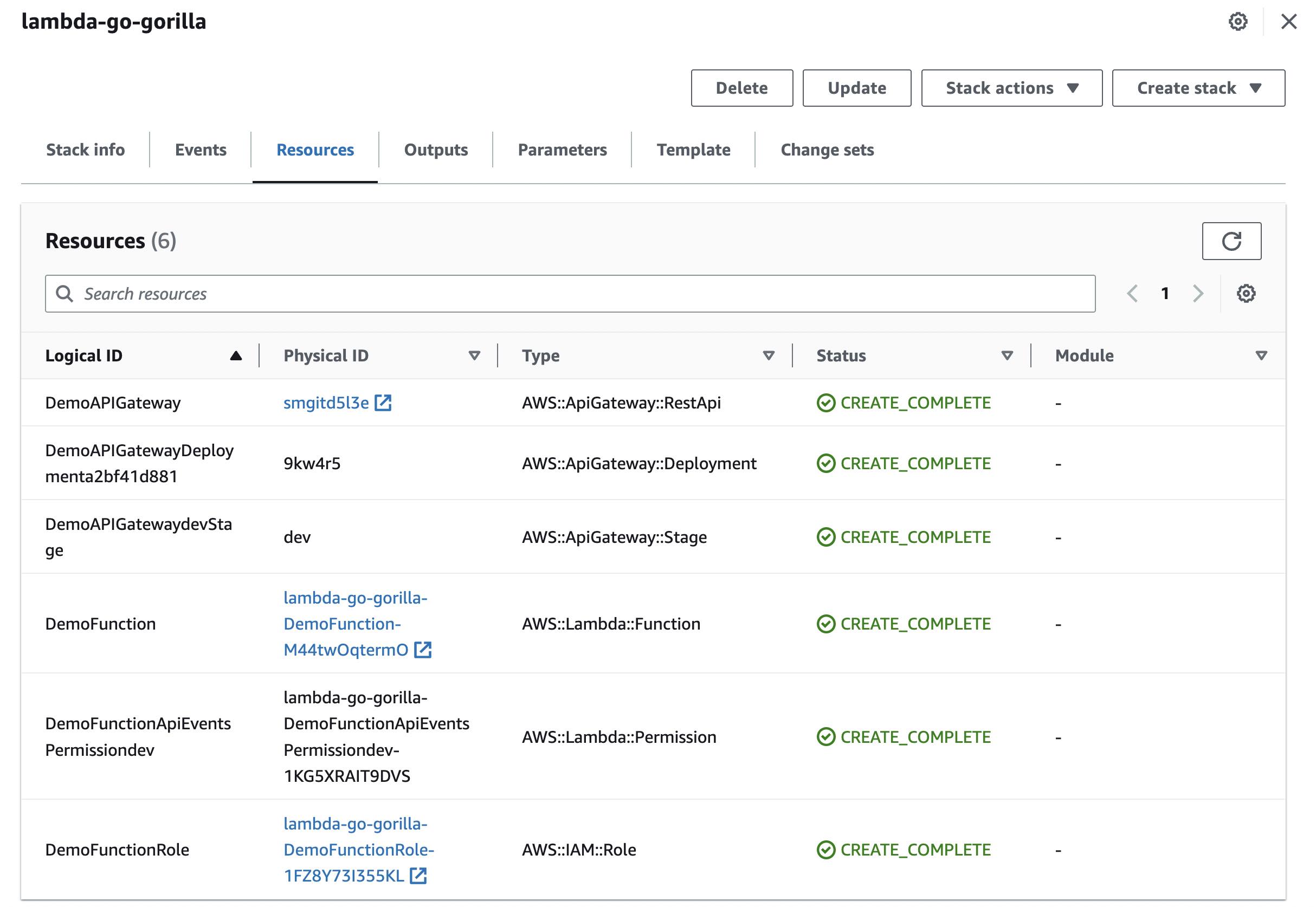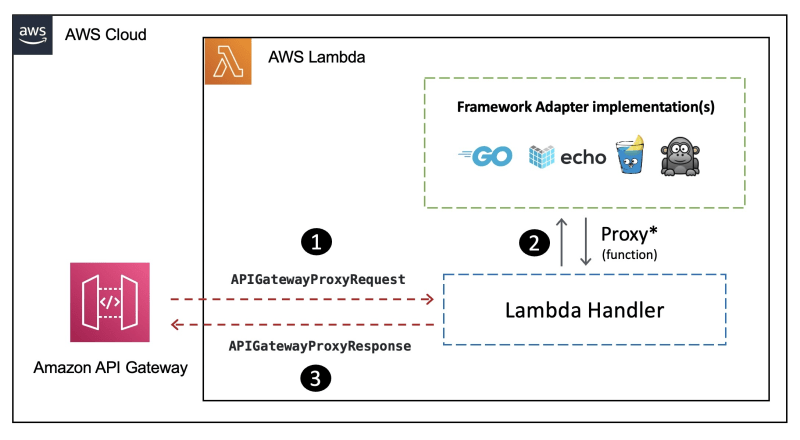How Do I Run My Go Applications in a Serverless Way?
In this tutorial, learn how to run Go REST APIs as Lambda functions using the AWS Lambda Go API Proxy.
Join the DZone community and get the full member experience.
Join For FreeThe Go programming language has always had rich support for building REST APIs. This includes an excellent standard library (net/HTTP) along with many popular packages such as Gorilla mux, Gin, Negroni, Echo, Fiber, etc.
Using AWS Lambda Go runtime, you can use Go to build AWS Lambda functions. Imagine a web app that needs to authenticate users, store user data, and send emails. A Serverless approach for this would be to implement each functionality/API as a separate Lambda function. For example, you could have a Lambda function to handle user registration, another to handle user login, and so on.
This is great if you are building everything from scratch. But what if you wanted to run existing Go REST APIs as AWS Lambda functions?
Broadly speaking, you would need to:
- Split the existing code into multiple Lambda functions.
- Refactor each of them to work with AWS Lambda Go runtime APIs.
With the AWS Lambda Go API Proxy, there is an easier way.
This blog will demonstrate how to run existing Go frameworks-based APIs in a serverless way with AWS Lambda and Amazon API Gateway. You will walk through simple code examples for the net/http package, and gorilla and echo frameworks to understand how they work and deploy them using AWS Serverless Application Model.
The code is available in this GitHub repository.
Let's start with a brief introduction to the AWS Lambda Go API Proxy.
AWS Lambda Go API Proxy: How Does It Work?
The aws-lambda-go-api-proxy package makes it easy to run Go APIs written using frameworks (such as Gin) with AWS Lambda and Amazon API Gateway. In addition to adapter implementations for the net/http (Go standard library) and other frameworks such as gorilla/mux, echo, etc., aws-lambda-go-api-proxy also declares a core package that contains utility methods and interfaces to translate API Gateway proxy events into Go's default http.Request and http.ResponseWriter objects and allows you to adapt any framework to the AWS Lambda Go runtime.
Here is a gist of how it works at a high level:
- The API Gateway request is accepted by the Lambda function handler.
- The function handler proxies the request to the adapter implementation corresponding to the framework.
- Finally, the API Gateway proxy response is returned to the client.
Let's look into the framework-specific behavior.
gorilla/mux Library
Package gorilla/mux implements a request router and dispatcher for matching incoming requests to their respective handler. Like http.ServeMux in the Go standard library, mux.Router matches incoming requests against a list of registered routes and calls a handler for the route that matches the URL or other conditions. Because gorilla/mux implements the http.Handler interface, it is compatible with http.ServeMux.
Here is a simple example of a Lambda function that uses an adapter implementation to work with gorilla/mux package:
var gorillaLambda *gorillamux.GorillaMuxAdapter
func init() {
r := mux.NewRouter()
r.HandleFunc("/ping", func(w http.ResponseWriter, r *http.Request) {
json.NewEncoder(w).Encode(Response{From: "gorilla", Message: time.Now().Format(time.UnixDate)})
})
gorillaLambda = gorillamux.New(r)
}
func Handler(ctx context.Context, req events.APIGatewayProxyRequest) (events.APIGatewayProxyResponse, error) {
r, err := gorillaLambda.ProxyWithContext(ctx, *core.NewSwitchableAPIGatewayRequestV1(&req))
return *r.Version1(), err
}
func main() {
lambda.Start(Handler)
}
- In the
initfunction:gorillamux.Newfunction takes in amux.Router(which has theHTTPGETroute defined) and returns agorillamux.GorillaMuxAdapter. - In the
Handlerimplementation:- The
Proxy(orProxyWithContext) method of thegorillamux.GorillaMuxAdapterobject receives theevents.APIGatewayProxyRequest, converts it into ahttp.Requestobject, and sends it to themux.Routerfor routing. - It returns a proxy response object (
events.APIGatewayProxyResponse) generated from the data written to the response writer (http.ResponseWriter).
- The
Echo Framework
Echo is another popular Go web framework that is minimalist, yet highly extensible.
Here is a simple example of a Lambda function that uses an adapter implementation to work with the echo framework:
var echoLambda *echoadapter.EchoLambda
func init() {
e := echo.New()
e.Use(middleware.Logger())
e.Use(middleware.Recover())
e.GET("/ping", func(c echo.Context) error {
return c.JSON(http.StatusOK, Response{From: "echo", Message: time.Now().Format(time.UnixDate)})
})
echoLambda = echoadapter.New(e)
}
func Handler(ctx context.Context, req events.APIGatewayProxyRequest) (events.APIGatewayProxyResponse, error) {
return echoLambda.ProxyWithContext(ctx, req)
}
func main() {
lambda.Start(Handler)
}
The concept is similar to the previous example.
- The
initfunction sets up the router (echo.Echo) and passes it into theechoadapter.Newthar returns aechoadapter.EchoLambda(the adapter implementation). - In the
Handlerfunction:- The
ProxyWithContextmethod of theechoadapter.EchoLambdaobject receives theevents.APIGatewayProxyRequestobject and converts it into anhttp.Requestobject and sends it toecho.Echofor routing. - It returns a proxy response object (
events.APIGatewayProxyResponse) generated from the data written to the response writer (http.ResponseWriter).
- The
net/http Package
The adapter implementation for net/http also works the same way. Here is the code snippet:
var httpLambda *httpadapter.HandlerAdapter
func init() {
http.HandleFunc("/ping", func(w http.ResponseWriter, r *http.Request) {
json.NewEncoder(w).Encode(Response{From: "net/http", Message: time.Now().Format(time.UnixDate)})
})
httpLambda = httpadapter.New(http.DefaultServeMux)
}
func Handler(ctx context.Context, req events.APIGatewayProxyRequest) (events.APIGatewayProxyResponse, error) {
return httpLambda.ProxyWithContext(ctx, req)
}
func main() {
lambda.Start(Handler)
}
- To use with the standard library, the
httpadapter.Newfunction takes in ahttp.Handler(which has the route defined) and returns ahttpadapter.HandlerAdapterobject. - The
ProxyWithContentmethod on thehttpadapter.HandlerAdaptercan then be used as a Lambda handler.
Let's see how this works in practice.
Deploy to AWS Lambda
Let's deploy each of these functions to AWS Lambda using the SAM CLI.
Prerequisites
Before you proceed, make sure you have the Go programming language (v1.18 or higher) and AWS SAM installed.
Clone the project and change it to the right directory:
git clone https://github.com/build-on-aws/golang-apis-on-aws-lambda
cd golang-apis-on-aws-lambda
gorilla/mux-Based Lambda Function
First, update the CodeUri in template.yaml to gorilla/ (which is the local folder where the code is located).
Build the function:
sam build
#expected output
Building codeuri: <path>/lambda-go-api-proxy-getting-started/gorilla runtime: go1.x metadata: {} architecture: x86_64 functions: DemoFunction
Running GoModulesBuilder:Build
Build Succeeded
....
Deploy the function (follow the SAM CLI prompts):
export STACK_NAME=lambda-go-gorilla
sam deploy --stack-name $STACK_NAME --guided
# response to the prompts
Stack Name [lambda-go-gorilla]: <press enter>
AWS Region [us-east-1]: <enter alternate region or press enter>
#Shows you resources changes to be deployed and require a 'Y' to initiate deploy
Confirm changes before deploy [y/N]: n
#SAM needs permission to be able to create roles to connect to the resources in your template
Allow SAM CLI IAM role creation [Y/n]: y
#Preserves the state of previously provisioned resources when an operation fails
Disable rollback [y/N]: n
DemoFunction may not have authorization defined, Is this okay? [y/N]: y
Save arguments to configuration file [Y/n]: y
SAM configuration file [samconfig.toml]: <press enter>
SAM configuration environment [default]: <press enter>
Once the deployment is complete, navigate to AWS CloudFormation console to check the deployed stack and associated resources. These include the Lambda function, API Gateway (REST API), IAM role, etc.

You should see the API Gateway endpoint as the SAM CLI output (it will be different in your case) or the CloudFormation Outputs section.
-----------------------------------------------------------------------------------------------------
CloudFormation outputs from deployed stack
--------------------------------------------------------------------------------------------------------
Outputs
--------------------------------------------------------------------------------------------------------
Key APIGWEndpoint
Description API Gateway Endpoint
Value https://whrd2yy3ug.execute-api.us-east-1.amazonaws.com/dev/ping
--------------------------------------------------------------------------------------------------------
Successfully created/updated stack - lambda-go-gorilla in us-east-1
To test the function, invoke the API Gateway using the following command:
export API_ENDPOINT=<enter the API Gateway endpoint here>
curl $API_ENDPOINT
You should get a JSON response similar to the following:
{
"from": "gorilla",
"message": "Tue Jun 27 18:10:54 UTC 2023"
}
net/http and echo-Based Lambda Functions
Before you deploy either of these, make sure to update the CodeUri in template.yaml to refer to the local folder where the code is located:
http-stdlib/in case ofnet/httppackage.echo/in case ofechoframework.
Build and deploy the function (respond to the prompts, just like before):
sam build
# change the stack name to lambda-go-echo in case of "echo" framework
export STACK_NAME=lambda-go-nethttp
sam deploy --stack-name $STACK_NAME --guided
You can test the function by invoking the API Gateway endpoint:
export API_ENDPOINT=<enter your API endpoint here>
curl $API_ENDPOINT
You should get a JSON response similar to the following:
{
"from": "net/http",
"message": "Tue Jun 27 18:20:42 UTC 2023"
}
In case of echo framework, you should get a JSON response similar to the following (notice the different name in the from field):
{
"from": "echo",
"message": "Tue Jun 27 18:30:25 UTC 2023"
}
That's it! You have successfully deployed your Go APIs as AWS Lambda functions.
Cleanup
Once you are done, delete the stacks:
sam delete --stack-name lambda-go-gorilla
sam delete --stack-name lambda-go-nethttp
sam delete --stack-name lambda-go-echo
Conclusion
This blog post introduced you to the AWS Lambda Go API Proxy, and how its framework/package (for gorilla/mux, echo and net/http) specific adapter implementations allow you to run existing Go applications as AWS Lambda functions fronted by an API Gateway. You learned the basic concepts with simple code examples, deployed these functions using AWS SAM CLI, and verified it by invoking the API Gateway endpoint.
The AWS Lambda Go API Proxy also supports Gin, which is one of the most popular Go web frameworks. The second part of this blog will demonstrate how to run existing Gin framework-based Go applications as AWS Lambda functions with the help of a simple (yet practical) URL shortener service.
Stay tuned!
Published at DZone with permission of Abhishek Gupta, DZone MVB. See the original article here.
Opinions expressed by DZone contributors are their own.


Comments